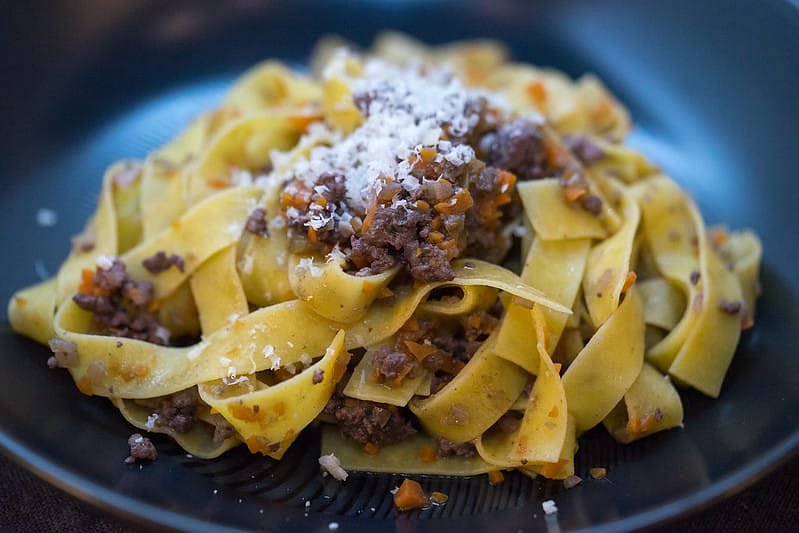Recipe: 'White' Sausage Ragu
A delicious meat sauce, plus reflections on how food cultures travel the world.

Posted on Mon 11 Dec 2023 · by Oliver Haenlein
It’s surely a wonderful thing that we can order whatever food we want wherever we end up in the world.I’ve enjoyed sushi in Rome, ordered takeaway Thai food in Switzerland, and gone for a curry in Krakow!
We obviously do have to be aware, however, that what we end up eating in such situations is not necessarily a faithful representation of the actual cuisine. Partly because some of its authenticity, nuance and variation will get lost as it travels, and partly because the flavours and textures will gradually adapt to the preferences of the people in its new home. Inevitably we end up with a hybrid. 'British' Indian chicken Tikka Marsala with chips, or ‘American’ Mexican nachos covered in cheese sauce. That’s not to say this is necessarily a terrible thing, it’s part of the evolutionary story of humans and their food. But we do also have to make sure that we don't homogenise. That we continue to honour the roots of the food, its stories and its diversity.
As Italian food has travelled it has often become oversimplified and more crude. Generally it's very saucy, sweet, garlicky and red; with a motherload of cheese slung on top. Maybe often that’s what the international community wants from Italian food, so that’s what gets made. But that’s betrayal. At its best, in my experience and humble opinion, Italian food is subtle, complex and endless in its variations. I have even found some visitors to Italy seem disappointed with the food, mistaking delicateness and refinement for blandness, instead craving the overly-powerful wet mess that has sometimes become the norm overseas.
One of the things I really enjoyed when we first moved to Italy was discovering all the dishes made without tomato. It turns it out Italian food isn’t all red at all! Quite the opposite. On menus many dishes will be described as ‘in bianco’, made ‘in white', simmered in white wine, stock or even just water. The result is often something much more elegant, in which you can taste all the finer notes of the meats, vegetables and herbs. Soups, meat dishes and pasta sauces, all without the omnipresent can of chopped tomatoes thrown into the pan, would you believe it?! This is the kind of thing that gets lost when the globalisation of food homogenises a food culture. A whole part of a cuisine gets left at the station, while meatballs, pizza and pasta with tomato sauce zip their way off around the world.
Here is the recipe for one such dish. A ‘white' ragu made with delicious Italian sausage meat. Give it a try; tomato-less pasta sauces could be a surprising discovery if they're not already part of your repetoir. If you can’t find Italian sausages, good local ones with a high meat content are fine too. Sausage works great in a white ragu because the meat is rich and intensely flavoured, but you could do the same recipe with normal pork or beef mince. The dish is built in a similar way to how you might make a more traditional Bolognese. First a ‘soffrito’ using the holy trinity of carrot, celery and onion, followed by our meat, wine and herbs. We add a little water for liquid instead of tomato. It reduces with the wine, meat and vegetables to create a thick and velvety stock which coats the pasta beautifully. Ignore even the temptation to use stock, there is so much flavour in the ingredients already in use, so your finished dish will be punchy yet balanced.
Recipe: White Sausage Ragu
Serves 4
- 1 tbsp Extra Virgin Olive Oil
- 3 Italian Pork Sausages, or good quality ones with high meat and fat ratio
- 1 Large Stick of Celery
- 1 Medium/Large Carrot
- 1 White Onion
- 2 Garlic Cloves, Finely Sliced
- 1 Large Glass Dry White Wine
- Half tsp of Fennel Seeds
- 1 Pinch of Rosemary
- 3 Leaves Fresh Sage
- Salt and Pepper, to Season
- Parmesan Cheese, to Serve
1 Remove the skins from the sausages and fry in a pan with the olive oil. Break the meat up with a wooden spoon or a whisk as it cooks, until in small pieces. Once lightly browned, remove from the pan and set aside. If you have very fatty sausages and you're health conscious, you could remove a little of the fat that remains in the pan if it's really abundant. Leave a good amount in though, that's important!
2 Finely chop the onion, carrot and celery and add to the pan you used for the sausage. Sautee in the fat over a medium heat for at least 10 mins, until the vegetables are softened well. Add the garlic, and cook for a further 2 mins. Add the cooked sausage meat and stir well. Pour in the wine, and simmer, stirring, until the liquid has disappeared.
3 Add a few glasses of water, until the sauce is very loose. Add the herbs and fennel seeds. Simmer for at least an hour on a low/medium heat, adding a little more water every time the sauce gets too dry. The finished sauce should be thick so it coats the pasta, so at the end don't stop cooking until it's fairly dry. Season well with salt and pepper. Add your cooked pasta of choice to the pan and toss well with a little of the cooking water. Serve with Parmesan cheese on top (you can also stir in a little of the cheese to the pasta and sauce before serving for extra flavour!)
